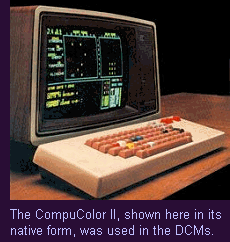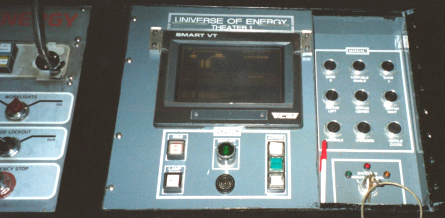 |
Home > Pavilion > Ride/Show Technology > Ride Operator Consoles

The original Ride Operator Console featured a color touch-screen system, know as the "DCM",
or "Display Control Module". Though graphic touch-screens are hardly cutting-edge now--being literally
as close as your nearest McDonalds service counter--the DCM was a dramatic innovation in ride control
in its day. A single touch-screen could take the place of a large panel of pushbuttons and indicator lights,
offering a much greater degree of control and status information.
Like the Ride Control System that it interacted with (GPRCS), the DCM became a "stock" component. The
same design could be used for any attraction. Software customized each unit to the ride in which it was
installed, creating a display and control panel suited to each ride's characteristics and needs.


Universe of Energy's DCM displayed a rough outline of the ride path, with a purple line indicating the
path of the "Guidewire". Blue lines indicated the show doors.
A surprising amount of information could be conveyed with these simple lines, by changing colors (the
blue lines for the doors turned white when the doors were fully open, and the purple Guidewire lines
turned white when the Guidewire was inactive); changing position (the Guidewire lines over the turntables
changed direction to indicate the position of the turntables); and blinking (the door and turntable Guidewire
lines blinked when either were in motion). The blank space surrounded by the purple Guidewire line
was used to display errors (in red) and other special messages.
White rectangles acted as command buttons for the doors, turntable, dispatch, etc; Larger yellow squares acted as
"Command Enter" and "Command Cancel" buttons. A command wasn't accepted until the "Command Enter" square was touched,
to guard against an accidental activation of a critical function.

The Renaissance Machine
 The DCMs were custom-built (possibly by MAPO), but they were based on components from other companies. At the
heart of the unit was an early personal computer, the CompuColor II (built in 1979, it predated the ubiquitious
"PC" by several years). Advertisements of the day dubbed it "The Renaissance Machine", an apt description for a
machine that in many ways was ahead of its time. Its unparalleled combination of a crisp color display,
programmable video attributes, and built-in serial port made it ideal for such an application. The CompuColors
were removed from their original cabinets (as shown in the photo at right) and fitted to a custom, rack-mount
chassis. Sourrounding the screen was a touch-screen system by Carrol Touch Technologies. It consisted of rows
of infrared emitters and receptors along each axis. It effectivley created an invisible infrared grid. When a
finger was pointed at the screen, it broke one or more of these infrared beams, signaling to the computer where
the screen had been touched. A removable black bezel--made of a special plastic that allowed the infrared light
to pass through--surrounded the screen, giving the installation a finished look.
The DCMs were custom-built (possibly by MAPO), but they were based on components from other companies. At the
heart of the unit was an early personal computer, the CompuColor II (built in 1979, it predated the ubiquitious
"PC" by several years). Advertisements of the day dubbed it "The Renaissance Machine", an apt description for a
machine that in many ways was ahead of its time. Its unparalleled combination of a crisp color display,
programmable video attributes, and built-in serial port made it ideal for such an application. The CompuColors
were removed from their original cabinets (as shown in the photo at right) and fitted to a custom, rack-mount
chassis. Sourrounding the screen was a touch-screen system by Carrol Touch Technologies. It consisted of rows
of infrared emitters and receptors along each axis. It effectivley created an invisible infrared grid. When a
finger was pointed at the screen, it broke one or more of these infrared beams, signaling to the computer where
the screen had been touched. A removable black bezel--made of a special plastic that allowed the infrared light
to pass through--surrounded the screen, giving the installation a finished look.
Virtually identical units--with different software--were used throughout Communicore as games and interactive displays.
Among the most popular was Energy Exchange's "Taxi Game".

Back From the Future
Sometime in the early 90's, the innovative DCM touch screens were eliminated--to be replaced with a conventional
panel of pushbuttons and a static graphic display. We're not certain why the system
was replaced, but it clearly represents a huge step backward. The new system doesn't begin to offer the flexibility or
the informational content of the original DCM--not to mention that it's just plain not as elegant or fun as a touch-screen.


Who Needs Us?
The extroardinary complexity Universe of Energy's ride system would make it nearly impossible to operate without
computer control. The ride control computer handles everything from guidance of the two sets of vehicles, to the
precise alignment of the turntables, to synchronizing the ride with show elements. The extent of the automation
leads some Cast Members to question why they're even needed. What it comes down to is safety, which is something
much better suited to a human operator than to automation. At key points during the ride--such as when the turntables
are to rotate, or vehicles are to dispatch to another area of the ride--the computer prompts the Cast Member for
an okay to proceed. If they fail to respond to the prompt, it "times out" and the entire ride shuts down.
This type of "failsafe" is roughly analogous to the "Dead Man" switch on the Monorails: it requires intervention to
keep the ride running, rather than to stop it once it is in motion. Given the immense size and sheer power of the
vehicles, show doors, and turntables--and the fact that guests misjudge the dangers and jump out of the ride for varying
reasons--the Cast Member is easily the most critical safety element.


Related Pages
Ride Control System
Read about the origins of the DCM and how it fit into the GPRCS ride control system.
Carroll Touch Technology *
Carroll Touch Technology, which created the touch-screen systems used in the DCMs and throughout EPCOT
Center (Communicore games and exhibits, World Key Information System), has been acquired by
Elo Touchsystems. You may visit their Web site here.
Note: Links above marked with an asterisk *,
link outside this site. They will open in a new window, so you do not lose your place here.

|
 |
|
|





